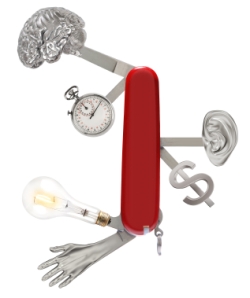I just read a super inspiring article by Michael Sammet that wraps resilience,  resourcefulness and empathy together in one narrative of creative, collaborative adaptation to the BIG changes upon us. Just my cup of tea, so to speak, since I just finished teaching “resourcefulness” as a teleclass and will teach live at Schumacher College May 31-June 4.
resourcefulness and empathy together in one narrative of creative, collaborative adaptation to the BIG changes upon us. Just my cup of tea, so to speak, since I just finished teaching “resourcefulness” as a teleclass and will teach live at Schumacher College May 31-June 4.
I especially like how Sammet defines his terms.
Resilience in design “means creating objects, templates and platforms that allow people and systems to survive and even thrive in a complex and uncertain planet. … Resilience thinking integrates social and environmental factors into a holistic framework that helps users prepare for —or even take advantage of—shocks to a system.”
“Resourcefulness” Sammet says,” allows people to create, obtain and maintain necessities for living using less resources and energy. It confronts hyperconsumption by helping us rethink our relationship to our things as we decide to build, share and repair the things we want and need.”
Resilience is the property of a well designed adaptive system and resourcefulness is the ability to remake and remix as systems go through rapid change.
This is “simplicity and frugality” for the 21st century. It goes beyond the personal change and public protest to understanding we are together in a new time of adaptation which can be highly creative, collaborative and innovative. We need to “rapid-prototype” solutions that are simple, inexpensive, elegant and a remix of what already exists. It is post “Chicken Little”. It is MacGiver (a resourceful secret agent able to solve complex problems with everyday materials he finds at hand).
Joe Dominugez (1938-1997), my coauthor of Your Money or Your Life, was the consummate “MacGiver”, and he taught me to have a combination of street smarts and engineering pragmatism to generate simple, human scale solutions to big problems. I added sociability to the mix, making creative adaptation fun and compassionate as well.
Sammet finishes the article this way:
While our new information age continues to deplete social and ecological resources, it has made us more empathic. We are wired to care and share and are using precious hydrocarbons to evolve our connectivity to one another and our planetary boundaries. This expanded socio-ecological empathy is the future of sustainable design. In a sense, we are trying to knit together communities and systems as fast as they fall apart in an accelerated dialectic of the entropy and empathy that should ultimately serve as a deep source of creativity and inspiration for all designers of sustainability.
Read the whole article here
